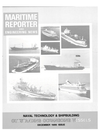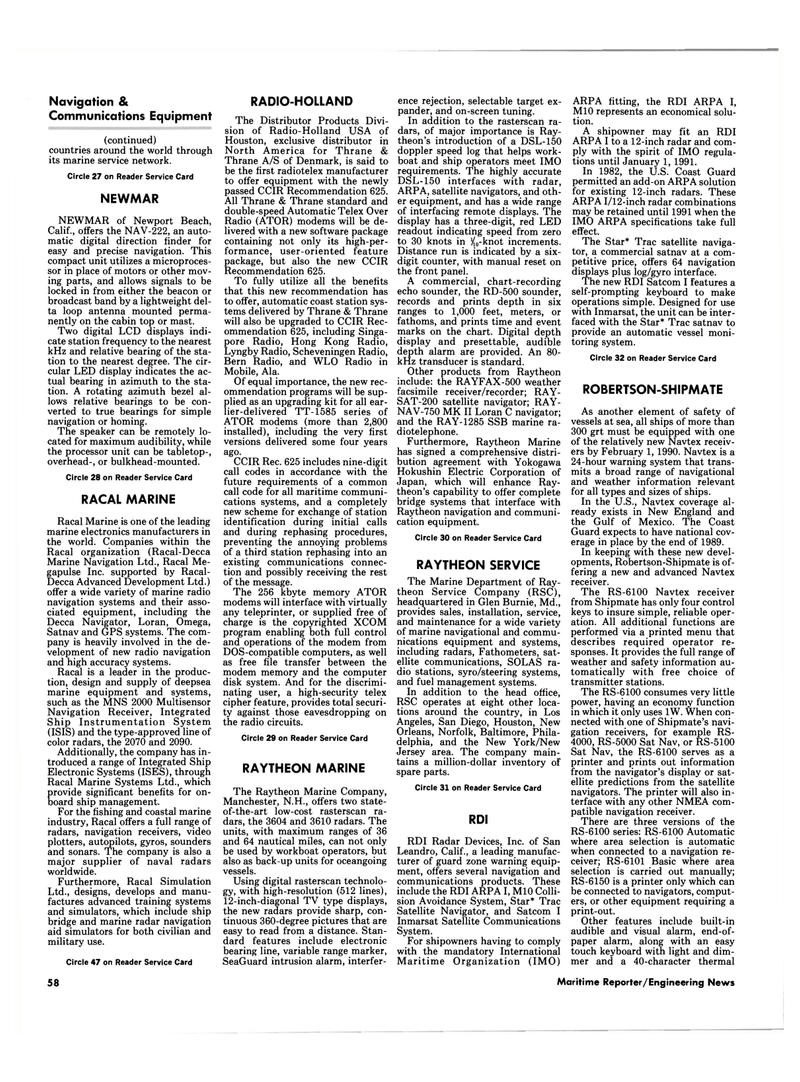
Page 56: of Maritime Reporter Magazine (December 1986)
Read this page in Pdf, Flash or Html5 edition of December 1986 Maritime Reporter Magazine
RADIO-HOLLAND
The Distributor Products Divi- sion of Radio-Holland USA of
Houston, exclusive distributor in
North America for Thrane &
Thrane A/S of Denmark, is said to be the first radiotelex manufacturer to offer equipment with the newly passed CCIR Recommendation 625.
All Thrane & Thrane standard and double-speed Automatic Telex Over
Radio (ATOR) modems will be de- livered with a new software package containing not only its high-per- formance, user-oriented feature package, but also the new CCIR
Recommendation 625.
To fully utilize all the benefits that this new recommendation has to offer, automatic coast station sys- tems delivered by Thrane & Thrane will also be upgraded to CCIR Rec- ommendation 625, including Singa- pore Radio, Hong Kong Radio,
Lyngby Radio, Scheveningen Radio,
Bern Radio, and WLO Radio in
Mobile, Ala.
Of equal importance, the new rec- ommendation programs will be sup- plied as an upgrading kit for all ear- lier-delivered TT-1585 series of
ATOR modems (more than 2,800 installed), including the very first versions delivered some four years ago.
CCIR Rec. 625 includes nine-digit call codes in accordance with the future requirements of a common call code for all maritime communi- cations systems, and a completely new scheme for exchange of station identification during initial calls and during rephasing procedures, preventing the annoying problems of a third station rephasing into an existing communications connec- tion and possibly receiving the rest of the message.
The 256 kbyte memory ATOR modems will interface with virtually any teleprinter, or supplied free of charge is the copyrighted XCOM program enabling both full control and operations of the modem from
DOS-compatible computers, as well as free file transfer between the modem memory and the computer disk system. And for the discrimi- nating user, a high-security telex cipher feature, provides total securi- ty against those eavesdropping on the radio circuits.
Circle 29 on Reader Service Card
RAYTHEON MARINE ence rejection, selectable target ex- pander, and on-screen tuning.
In addition to the rasterscan ra- dars, of major importance is Ray- theon's introduction of a DSL-150 doppler speed log that helps work- boat and ship operators meet IMO requirements. The highly accurate
DSL-150 interfaces with radar,
ARPA, satellite navigators, and oth- er equipment, and has a wide range of interfacing remote displays. The display has a three-digit, red LED readout indicating speed from zero to 30 knots in X0-knot increments.
Distance run is indicated by a six- digit counter, with manual reset on the front panel.
A commercial, chart-recording echo sounder, the RD-500 sounder, records and prints depth in six ranges to 1,000 feet, meters, or fathoms, and prints time and event marks on the chart. Digital depth display and presettable, audible depth alarm are provided. An 80- kHz transducer is standard.
Other products from Raytheon include: the RAYFAX-500 weather facsimile receiver/recorder; RAY-
SAT-200 satellite navigator; RAY-
NAV-750 MK II Loran C navigator; and the RAY-1285 SSB marine ra- diotelephone.
Furthermore, Raytheon Marine has signed a comprehensive distri- bution agreement with Yokogawa
Hokushin Electric Corporation of
Japan, which will enhance Ray- theon's capability to offer complete bridge systems that interface with
Raytheon navigation and communi- cation equipment.
Circle 30 on Reader Service Card
RAYTHEON SERVICE
The Marine Department of Ray- theon Service Company (RSC), headquartered in Glen Burnie, Md., provides sales, installation, service, and maintenance for a wide variety of marine navigational and commu- nications equipment and systems, including radars, Fathometers, sat- ellite communications, SOLAS ra- dio stations, syro/steering systems, and fuel management systems.
In addition to the head office,
RSC operates at eight other loca- tions around the country, in Los
Angeles, San Diego, Houston, New
Orleans, Norfolk, Baltimore, Phila- delphia, and the New York/New
Jersey area. The company main- tains a million-dollar inventory of spare parts.
Navigation &
Communications Equipment (continued) countries around the world through its marine service network.
Circle 27 on Reader Service Card
NEWMAR
NEWMAR of Newport Beach,
Calif., offers the NAV-222, an auto- matic digital direction finder for easy and precise navigation. This compact unit utilizes a microproces- sor in place of motors or other mov- ing parts, and allows signals to be locked in from either the beacon or broadcast band by a lightweight del- ta loop antenna mounted perma- nently on the cabin top or mast.
Two digital LCD displays indi- cate station frequency to the nearest kHz and relative bearing of the sta- tion to the nearest degree. The cir- cular LED display indicates the ac- tual bearing in azimuth to the sta- tion. A rotating azimuth bezel al- lows relative bearings to be con- verted to true bearings for simple navigation or homing.
The speaker can be remotely lo- cated for maximum audibility, while the processor unit can be tabletop-, overhead-, or bulkhead-mounted.
Circle 28 on Reader Service Card
RACAL MARINE
Racal Marine is one of the leading marine electronics manufacturers in the world. Companies within the
Racal organization (Racal-Decca
Marine Navigation Ltd., Racal Me- gapulse Inc. supported by Racal-
Decca Advanced Development Ltd.) offer a wide variety of marine radio navigation systems and their asso- ciated equipment, including the
Decca Navigator, Loran, Omega,
Satnav and GPS systems. The com- pany is heavily involved in the de- velopment of new radio navigation and high accuracy systems.
Racal is a leader in the produc- tion, design and supply of deepsea marine equipment and systems, such as the MNS 2000 Multisensor
Navigation Receiver, Integrated
Ship Instrumentation System (ISIS) and the type-approved line of color radars, the 2070 and 2090.
Additionally, the company has in- troduced a range of Integrated Ship
Electronic Systems (ISES), through
Racal Marine Systems Ltd., which provide significant benefits for on- board ship management.
For the fishing and coastal marine industry, Racal offers a full range of radars, navigation receivers, video plotters, autopilots, gyros, sounders and sonars. The company is also a major supplier of naval radars worldwide.
Furthermore, Racal Simulation
Ltd., designs, develops and manu- factures advanced training systems and simulators, which include ship bridge and marine radar navigation aid simulators for both civilian and military use.
Circle 47 on Reader Service Card
The Raytheon Marine Company,
Manchester, N.H., offers two state- of-the-art low-cost rasterscan ra- dars, the 3604 and 3610 radars. The units, with maximum ranges of 36 and 64 nautical miles, can not only be used by workboat operators, but also as back-up units for oceangoing vessels.
Using digital rasterscan technolo- gy, with high-resolution (512 lines), 12-inch-diagonal TV type displays, the new radars provide sharp, con- tinuous 360-degree pictures that are easy to read from a distance. Stan- dard features include electronic bearing line, variable range marker,
SeaGuard intrusion alarm, interfer-
Circle 31 on Reader Service Card
RDI
RDI Radar Devices, Inc. of San
Leandro, Calif., a leading manufac- turer of guard zone warning equip- ment, offers several navigation and communications products. These include the RDI ARPA I, M10 Colli- sion Avoidance System, Star* Trac
Satellite Navigator, and Satcom I
Inmarsat Satellite Communications
System.
For shipowners having to comply with the mandatory International
Maritime Organization (IMO)
ARPA fitting, the RDI ARPA I,
M10 represents an economical solu- tion.
A shipowner may fit an RDI
ARPA I to a 12-inch radar and com- ply with the spirit of IMO regula- tions until January 1, 1991.
In 1982, the U.S. Coast Guard permitted an add-on ARPA solution for existing 12-inch radars. These
ARPA I/12-inch radar combinations may be retained until 1991 when the
IMO ARPA specifications take full effect.
The Star* Trac satellite naviga- tor, a commercial satnav at a com- petitive price, offers 64 navigation displays plus log/gyro interface.
The new RDI Satcom I features a self-prompting keyboard to make operations simple. Designed for use with Inmarsat, the unit can be inter- faced with the Star* Trac satnav to provide an automatic vessel moni- toring system.
Circle 32 on Reader Service Card
ROBERTSON-SHIPMATE
As another element of safety of vessels at sea, all ships of more than 300 grt must be equipped with one of the relatively new Navtex receiv- ers by February 1, 1990. Navtex is a 24-hour warning system that trans- mits a broad range of navigational and weather information relevant for all types and sizes of ships.
In the U.S., Navtex coverage al- ready exists in New England and the Gulf of Mexico. The Coast
Guard expects to have national cov- erage in place by the end of 1989.
In keeping with these new devel- opments, Robertson-Shipmate is of- fering a new and advanced Navtex receiver.
The RS-6100 Navtex receiver from Shipmate has only four control keys to insure simple, reliable oper- ation. All additional functions are performed via a printed menu that describes required operator re- sponses. It provides the full range of weather and safety information au- tomatically with free choice of transmitter stations.
The RS-6100 consumes very little power, having an economy function in which it only uses 1W. When con- nected with one of Shipmate's navi- gation receivers, for example RS- 4000, RS-5000 Sat Nav, or RS-5100
Sat Nav, the RS-6100 serves as a printer and prints out information from the navigator's display or sat- ellite predictions from the satellite navigators. The printer will also in- terface with any other NMEA com- patible navigation receiver.
There are three versions of the
RS-6100 series: RS-6100 Automatic where area selection is automatic when connected to a navigation re- ceiver; RS-6101 Basic where area selection is carried out manually;
RS-6150 is a printer only which can be connected to navigators, comput- ers, or other equipment requiring a print-out.
Other features include built-in audible and visual alarm, end-of- paper alarm, along with an easy touch keyboard with light and dim- mer and a 40-character thermal 58 Maritime Reporter/Engineering News

 55
55

 57
57
